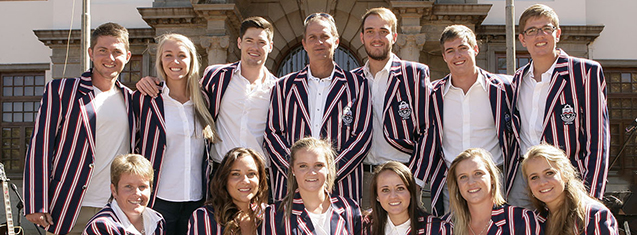
In 2014, Kovsies won gold at the USSA Tennis Tournament for the eighth consecutive time. Six players from last year's 12-man squad are in 2015 in Cape Town again available. Photo: Johan Roux
Duke Munro already has six gold medals from the USSA Tennis Tournament in his cupboard, and the Kovsie Tennis team would wish to bid him farewell in a fitting manner during what will probably be his last tournament in Cape Town.
This year's tournament, taking place from 30 November to 4 December 2015, will probably be Munro's last, since he is completing his Master's degree in Quantity Surveying at the University of the Free State (UFS).
He has competed in the USSA Tournament since 2009, and would like to help his team defend its proud record.
UFS aim for ninth consecutive title
Kovsies have won gold at the USSA Tournament for the last eight years. They are the only team who have been able to win the tournament since the combined format was adopted in 2010. In 2007 and 2008, their Women's team won the tournament, and in 2009, their Men's team.
Kovsies will play in group matches against the Universities of Venda and Wits on 30 November 2015, against the University of Cape Town's (UCT's) second team on 1 December 2015, and against UCT's first team on 2 December 2015. The cross and knockout matches will be played on 3 and 4 December 2015.
Other sporting codes
The Sevens Rugby team from the UFS will compete in the USSA Tournament in George on 30 November and 1 December 2015.
For the past two years, the team has won bronze, and will be playing three league matches on 30 November 2015 against the North-West University's Vaal Campus, Nelson Mandela Metropolitan University's Port Elizabeth Campus, and the Vaal University of Technology.
Kovsies are the current Varsity Sevens Champions after winning the title in Cape Town in April 2015.
Ten Kovsie swimmers took part in the USSA Tournament in Johannesburg from 28 November to 30 November 2015. Last year, Kovsies came third, but unfortunately some of their leading swimmers were unable to take part this year.
The Kovsie Table tennis team will participate in the USSA Tournament in Kimberley from 30 November to 4 December 2015.
Most of the USSA Tournaments in the other sporting codes were either postponed or cancelled because of the recent nationwide student protests. As a result of the protests, exams were written later, and tournaments would have taken place during the holidays.
Only the tennis, table tennis, Sevens rugby, swimming, and cricket B Division in East London will continue.
The USSA Soccer Tournament, to take place at the UFS and the Central University of Technology in Bloemfontein, was postponed until March 2016.